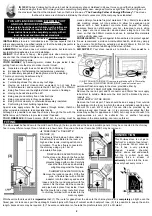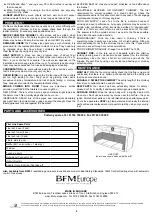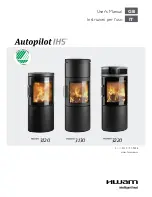
●
Fill 'little and often' - one log every 30 to 90 minutes is usually all
that is needed.
●
When first lighting, or reviving a fire from embers, use only very
small, thin, dry, sticks.
JOINERY WASTE
Dry wood offcuts will burn well, but don't expect
softwood waste to burn as cleanly or for as long as hardwood logs.
PROBLEMS?
Problems like those listed here are usually due to some difficulty with
the installation, chimney or fuel, so please check back through this
leaflet carefully. If necessary seek specialist advice.
SMOKE FROM THE CHIMNEY
A little smoke will be emitted when
the fire is first lit. Once hot, barely any smoke should be visible, though
steam may be seen if damp fuel is used. Use only VERY dry wood.
DAMAGED LINERS
The Portway stove gets very, very hot inside, it is
quite usual for the replaceable liners to crack or craze. They need only
be replaced when they have almost completely disintegrated. Help
them last longer by using only
very
dry
fuel.
HEAT OUTPUT:
A stove can heat a typical room of
about
12m³
volume for each kW of output, so a 5kW model can heat up to (12 x 5)
63m³, a room of about 5m square. The actual size depends on the
insulation and air-change ratio of the room. To attempt to heat a larger
room may cause excessive fuel use and damaging overheating.
CONDENSATION
onto cool surfaces inside the stove can be severe if
fuel is in any way damp.
Use only very dry fuel.
OVER-FIRING:
It is possible to leave the fire too long with the controls
set too high leading to 'over firing', seen as glowing metal parts,
excessive chimney temperature and risk of parts failing or chimney
fires. Always set control to the lowest practical setting.
SMOKE COMING INTO ROOM
Fumes are poisonous- smoke
emission must NEVER be tolerated, causes might be:
NEW STOVE: There is often a smell and sometimes slight fumes as
the paint cures. This normally stops after an hour or so.
INADEQUATE SEALS: Are all flue pipes and connectors
absolutely
gas-tight? Even the tiniest crack or gap can spoil the draught. Does the
inset appliances fully seal against the fireplace?
BLOCKED BAFFLE: Has soot and ash collected on the baffle above
the firebox?
UNSUITABLE, BLOCKED OR UN-SWEPT CHIMNEY: The first
requirement for correct operation is a sound chimney. Check the
requirements earlier in this document and in any case of doubt engage
a professional sweep or chimney engineer.
POOR AIR SUPPLY: Lack of air to the fire is a common cause of
smoking and poor performance. Air supply problems may be worse in
certain wind conditions (often incorrectly ascribed to 'downdraught',
which is in fact very rare), where air can be sucked out of the room.
The answer is to fit an outside air vent, as near to the fire as possible,
facing into the usual wind direction.
DOWNDRAUGHT: Wind can blow
down
a chimney if there is
something higher nearby such as a tree, hill or high building. Fitting an
anti-downdraught cowl to the chimney top can cure this. Types which
cannot be swept through are not recommended.
POOR CHIMNEY DRAUGHT- Draught in use MUST be 12Pa.
CHIMNEY FIRE:
In the rare event of deposits inside the chimney
igniting (roaring sound + dense smoke and sparks from the chimney)
immediately close the door, shut all air controls and call the fire
brigade. Prevent fires by using
very dry fuel
and having your chimney
swept regularly.
MAINTENANCE
MONTHLY
- With the fire cold, carefully check that the flue is clear and
unblocked, that there is no build-up of deposits behind the baffle and
that the door seals are sound.
ANNUALLY- SWEEP THE CHIMNEY
The entire length of the chimney
from stove to outlet should be swept annually.
NEW PARTS
Your stove has been extensively tested for safety -
please don't try to modify it and always obtain genuine spare parts
.
SURFACE FINISH
Wipe the stove body with a slightly damp cloth
when cool. Don't use aerosol spray or wax near the hot fire – they can
ignite. Painted steel parts can be refurbished using special spray paint.
Your stove generates
VERY
high temperatures. Eventually the internal
parts will require replacement. Help parts to last by using only
very dry
,
fuel.
PARTS AND ACCESSORIES
Portway spares Tel. 01782 339034 Fax 01782 339028
First Line Spare Parts
Liner set, base (3 pcs)
Liner set, Inner (4 pcs)
Liner set, rear (3 pcs)
Liners, side (2 pcs)
Baffle (B) (1 vermi 1 steel pc)
Window
Touch-up paint
Outside Air Connector Kit
Hot Air Duct kit
Adapter for vertical rear flue take-off
Also Available from BFM:
Freestanding and inset stoves. Marine model to Boat Safety Standards. 16kW Central Heating stove with automatic
control. Gas stoves.
MADE IN ENGLAND
BFM Europe Ltd, Trentham Lakes, Stoke on Trent, Staffordshire, England ST4 4TJ
www.bfm-europe.com Tel 01782 339000 Fax 01782 339009
4
LINER SET:
Inner Liners shown hatched, baffle at 'B'
The Portway stove designs are registered at the UK Patent Office and protected by Copyright © and UK Design Right, Glyn Hughes 2006-2017. Certain parts are UK Patent Applied
For. This document printed 28/11/2017. We are always striving to improve these products and may change their specification without notice.






















